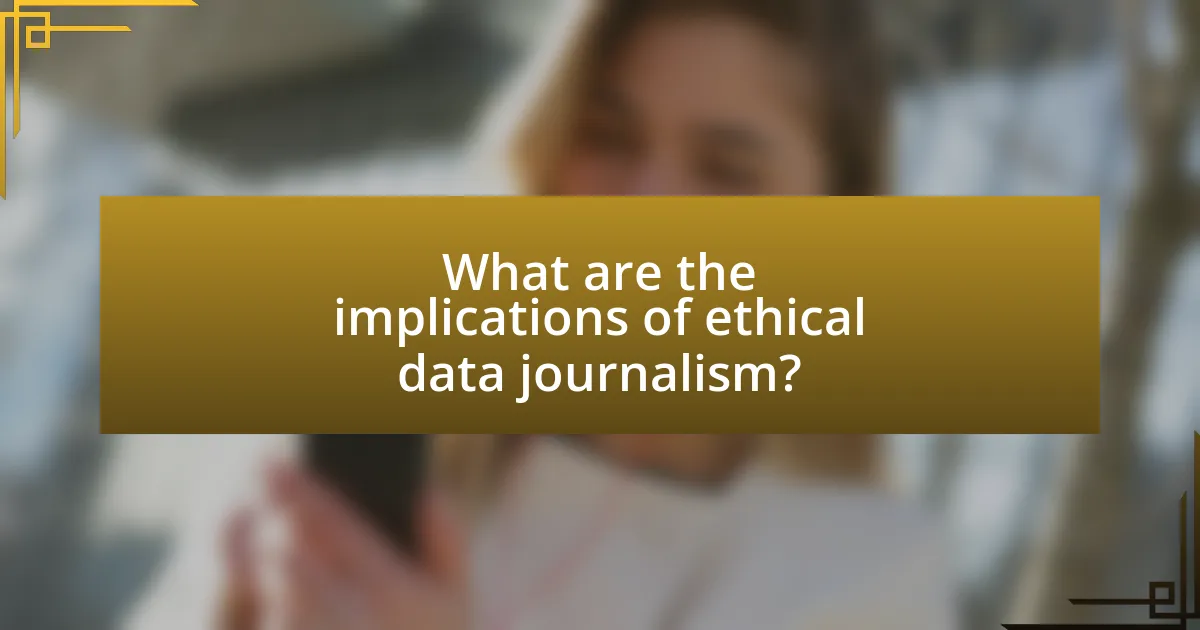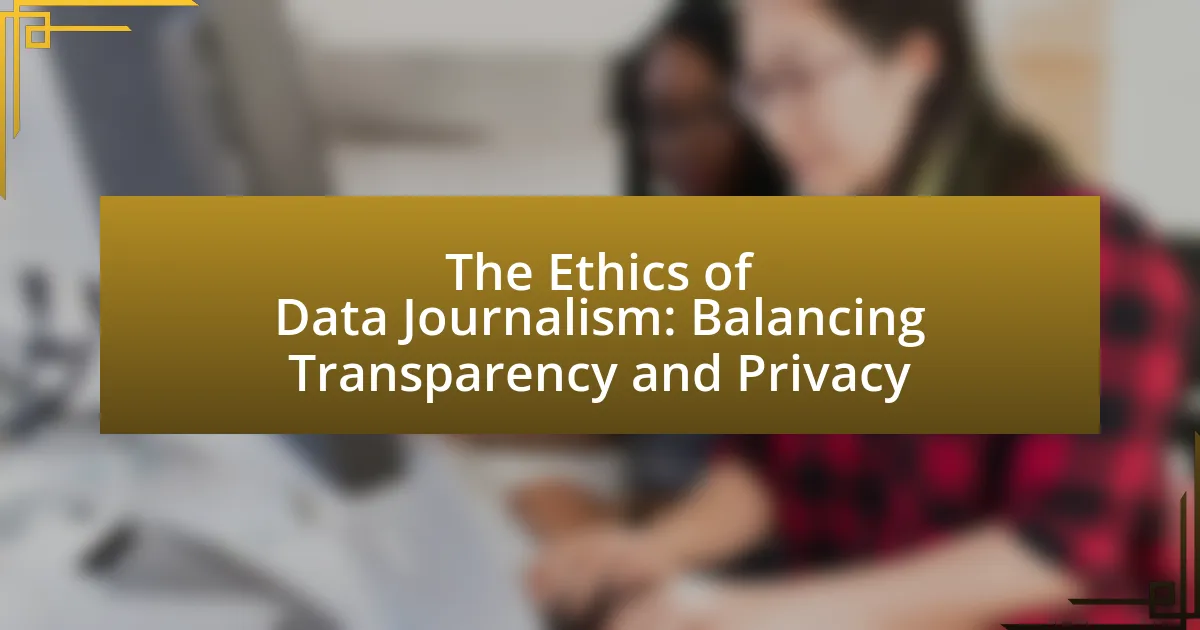The article focuses on the ethics of data journalism, emphasizing the critical balance between transparency and privacy. Key ethical considerations include transparency in data sourcing and methodologies, accuracy in reporting, privacy protection for individuals, and accountability for the impact of journalistic work. It discusses the importance of ethical guidelines, the implications of ethical practices on public trust, and the legal ramifications of unethical data journalism. Additionally, the article outlines best practices for ethical data collection, reporting, and communication, providing strategies for data journalists to navigate ethical dilemmas effectively.

What are the key ethical considerations in data journalism?
The key ethical considerations in data journalism include transparency, accuracy, privacy, and accountability. Transparency requires journalists to disclose their data sources and methodologies, ensuring that audiences understand how conclusions are drawn. Accuracy is crucial, as misrepresentation of data can lead to misinformation; for instance, a 2020 study by the Pew Research Center found that 64% of Americans believe that misinformation has caused confusion about basic facts. Privacy concerns arise when journalists handle sensitive data, necessitating careful consideration of how personal information is used and shared. Lastly, accountability involves journalists taking responsibility for their reporting, including correcting errors and addressing the impact of their work on individuals and communities. These considerations are essential for maintaining trust and integrity in the field of data journalism.
How does transparency play a role in data journalism ethics?
Transparency is essential in data journalism ethics as it fosters trust between journalists and their audience. By openly disclosing data sources, methodologies, and potential biases, journalists enable readers to critically assess the information presented. For instance, the Trust Project, which aims to enhance transparency in journalism, emphasizes that clear sourcing and methodology can significantly improve audience trust and engagement. This commitment to transparency not only upholds ethical standards but also empowers the public to make informed decisions based on the reported data.
What does transparency mean in the context of data journalism?
Transparency in the context of data journalism refers to the clear and open disclosure of data sources, methodologies, and potential biases involved in reporting. This principle ensures that audiences can understand how data was collected, analyzed, and interpreted, which fosters trust and accountability in journalistic practices. For instance, the Center for Data Innovation emphasizes that transparency allows readers to verify claims and assess the reliability of the information presented, thereby enhancing the credibility of the journalism.
Why is transparency important for audience trust?
Transparency is crucial for audience trust because it fosters credibility and accountability in communication. When organizations openly share their processes, data sources, and decision-making criteria, audiences are more likely to believe in the integrity of the information presented. Research indicates that 81% of consumers need to trust a brand before making a purchase, highlighting the direct correlation between transparency and trust. Furthermore, transparency reduces misinformation and enhances the audience’s ability to critically evaluate the content, thereby reinforcing their confidence in the source.
What privacy concerns arise in data journalism?
Privacy concerns in data journalism primarily include the potential for unauthorized data access, the risk of exposing personal information, and the ethical implications of data usage. Journalists often rely on large datasets that may contain sensitive information about individuals, which can lead to breaches of privacy if not handled properly. For instance, the Cambridge Analytica scandal highlighted how personal data can be misused for political purposes, raising awareness about the need for stringent data protection measures. Additionally, the aggregation of data can inadvertently reveal identities, even when individual data points are anonymized, as demonstrated by research from the re-identification of anonymized datasets. These concerns necessitate a careful balance between the public’s right to know and individuals’ rights to privacy in the practice of data journalism.
How do data journalists handle sensitive information?
Data journalists handle sensitive information by employing strict ethical guidelines and data protection measures. They prioritize the privacy of individuals by anonymizing data, ensuring that personally identifiable information is not disclosed. For instance, data journalists often aggregate data to present trends without revealing individual identities, which aligns with ethical standards set by organizations like the Society of Professional Journalists. Additionally, they seek informed consent when possible and assess the potential harm that could arise from publishing sensitive information, thereby balancing the public’s right to know with the need to protect vulnerable populations.
What are the potential risks of data exposure for individuals?
The potential risks of data exposure for individuals include identity theft, financial loss, and privacy violations. Identity theft occurs when personal information, such as Social Security numbers or bank details, is accessed and used fraudulently, leading to significant financial repercussions. According to the Federal Trade Commission, in 2020 alone, there were over 1.4 million reports of identity theft in the United States, highlighting the prevalence of this risk. Financial loss can arise from unauthorized transactions or the costs associated with recovering from identity theft. Additionally, privacy violations can result in unwanted surveillance, harassment, or discrimination, as personal data may be misused by malicious actors or even legitimate organizations. These risks underscore the importance of safeguarding personal information in an increasingly data-driven world.
How can data journalists balance transparency and privacy?
Data journalists can balance transparency and privacy by employing data anonymization techniques and adhering to ethical guidelines. Anonymization allows journalists to present data insights without revealing personally identifiable information, thus protecting individual privacy while still providing valuable information to the public. For instance, the General Data Protection Regulation (GDPR) emphasizes the importance of data protection, which encourages journalists to be transparent about their data sources and methodologies while ensuring that sensitive information is not disclosed. By following these practices, data journalists can maintain credibility and trust with their audience while respecting the privacy of individuals involved in their stories.
What strategies can be employed to ensure ethical reporting?
To ensure ethical reporting, journalists should adopt strategies such as adhering to established ethical guidelines, ensuring transparency in data sourcing, and prioritizing the privacy of individuals involved. Following ethical guidelines, such as those set by the Society of Professional Journalists, helps maintain integrity and accountability in reporting. Transparency in data sourcing involves clearly disclosing the origins of data and methodologies used, which fosters trust with the audience. Additionally, prioritizing privacy means taking steps to anonymize sensitive information and obtaining consent when necessary, thereby protecting individuals’ rights and dignity. These strategies collectively contribute to responsible journalism that respects both transparency and privacy.
How do ethical guidelines influence data journalism practices?
Ethical guidelines significantly influence data journalism practices by establishing standards for accuracy, transparency, and accountability. These guidelines compel journalists to verify data sources, ensuring that the information presented is credible and reliable. For instance, the Society of Professional Journalists emphasizes the importance of accuracy and fairness, which drives data journalists to fact-check their findings rigorously. Furthermore, ethical guidelines promote the responsible use of data, balancing the need for transparency with the protection of individual privacy. This is evident in the General Data Protection Regulation (GDPR), which mandates that journalists handle personal data with care, thereby shaping how data is collected and reported. Overall, adherence to ethical guidelines fosters trust between journalists and the public, enhancing the integrity of data journalism.

What are the implications of ethical data journalism?
Ethical data journalism has significant implications for public trust, accountability, and the protection of individual privacy. By adhering to ethical standards, data journalists can enhance the credibility of their reporting, fostering a more informed public. For instance, when journalists transparently disclose their data sources and methodologies, they allow audiences to critically evaluate the information presented, which can lead to increased trust in media outlets. Additionally, ethical data journalism emphasizes the importance of safeguarding personal data, ensuring that individuals’ privacy rights are respected. This is crucial in an era where data breaches and misuse of information are prevalent, as seen in incidents like the Cambridge Analytica scandal, which highlighted the risks associated with unethical data practices. Therefore, the implications of ethical data journalism extend beyond mere reporting; they shape the relationship between media, the public, and the ethical standards that govern data use.
How does ethical data journalism impact public perception?
Ethical data journalism significantly enhances public perception by fostering trust and credibility in the media. When journalists adhere to ethical standards, such as transparency in data sourcing and accuracy in reporting, they provide the public with reliable information that can influence opinions and behaviors. For instance, a study by the Pew Research Center found that 73% of Americans believe that accurate reporting is essential for a functioning democracy, highlighting the importance of ethical practices in shaping public trust. Furthermore, ethical data journalism mitigates misinformation, allowing audiences to make informed decisions based on factual data rather than sensationalized narratives. This commitment to ethical standards ultimately leads to a more informed and engaged public, reinforcing the role of journalism as a cornerstone of democracy.
What role does ethical data journalism play in shaping narratives?
Ethical data journalism plays a crucial role in shaping narratives by ensuring that information is presented accurately and responsibly, fostering trust among audiences. This approach emphasizes the importance of transparency in data sourcing and methodology, which helps to prevent misinformation and bias. For instance, the use of ethical guidelines, such as those outlined by the Society of Professional Journalists, mandates that journalists verify data before publication and disclose any potential conflicts of interest. By adhering to these principles, ethical data journalism not only enhances the credibility of the narratives but also empowers the public to make informed decisions based on reliable information.
How can ethical breaches affect the credibility of journalism?
Ethical breaches can significantly undermine the credibility of journalism by eroding public trust and damaging the reputation of media organizations. When journalists engage in unethical practices, such as fabricating sources or misrepresenting facts, it leads to skepticism among audiences regarding the accuracy and integrity of news reporting. For instance, a study by the Pew Research Center in 2021 found that 61% of Americans believe that news organizations are often influenced by powerful interests, indicating a growing distrust linked to perceived ethical violations. This decline in credibility can result in decreased audience engagement and a reluctance to rely on news sources for accurate information, ultimately harming the journalistic profession as a whole.
What are the legal implications of data journalism ethics?
The legal implications of data journalism ethics primarily involve issues of privacy, defamation, and intellectual property rights. Data journalists must navigate laws such as the General Data Protection Regulation (GDPR), which mandates strict guidelines on personal data usage, ensuring that individuals’ privacy is respected. Additionally, ethical breaches in data journalism can lead to defamation claims if the information presented is misleading or harmful to individuals or organizations. Furthermore, data journalists must consider copyright laws when using datasets, as unauthorized use can result in legal repercussions. These legal frameworks underscore the necessity for data journalists to adhere to ethical standards while reporting, balancing the public’s right to know with individuals’ rights to privacy and protection from harm.
How do laws regarding data protection influence journalistic practices?
Laws regarding data protection significantly influence journalistic practices by imposing strict guidelines on how journalists collect, store, and disseminate personal information. These regulations, such as the General Data Protection Regulation (GDPR) in Europe, require journalists to obtain consent from individuals before using their data, thereby prioritizing privacy and ethical considerations in reporting. For instance, under GDPR, failure to comply can result in hefty fines, which compels media organizations to adopt more rigorous data handling protocols. This legal framework encourages journalists to balance the need for transparency in reporting with the obligation to protect individual privacy, ultimately shaping the ethical landscape of data journalism.
What legal consequences can arise from unethical data journalism?
Unethical data journalism can lead to several legal consequences, including defamation, invasion of privacy, and breach of data protection laws. Defamation occurs when false information is published, damaging an individual’s reputation, which can result in lawsuits and financial penalties. Invasion of privacy can arise when journalists disclose personal information without consent, leading to legal action under privacy laws. Additionally, breaches of data protection regulations, such as the General Data Protection Regulation (GDPR) in Europe, can result in significant fines and legal repercussions for organizations that fail to handle data ethically. These legal frameworks underscore the importance of adhering to ethical standards in data journalism to avoid serious legal ramifications.

What best practices should data journalists follow?
Data journalists should prioritize transparency, accuracy, and ethical considerations in their work. Transparency involves clearly communicating data sources and methodologies to the audience, which builds trust and credibility. Accuracy is essential; journalists must verify data before publication to prevent misinformation, as evidenced by the 2016 U.S. presidential election, where inaccurate data reporting led to widespread confusion. Ethical considerations include respecting privacy and ensuring that data usage does not harm individuals or communities, aligning with guidelines from organizations like the Society of Professional Journalists, which emphasize the importance of minimizing harm.
How can data journalists ensure ethical data collection?
Data journalists can ensure ethical data collection by adhering to established ethical guidelines, obtaining informed consent, and prioritizing transparency. Following ethical guidelines, such as those set by the Society of Professional Journalists, helps maintain integrity and accountability in data practices. Obtaining informed consent from individuals whose data is being collected ensures respect for privacy and autonomy, as highlighted in the General Data Protection Regulation (GDPR), which mandates that individuals must be informed about how their data will be used. Prioritizing transparency involves clearly communicating data sources and methodologies to the audience, fostering trust and credibility in the reporting process.
What methods can be used to anonymize data effectively?
Effective methods to anonymize data include data masking, pseudonymization, and differential privacy. Data masking involves altering data to hide its original values while maintaining its usability for analysis. Pseudonymization replaces identifiable information with artificial identifiers, allowing data to be processed without revealing personal identities. Differential privacy adds random noise to datasets, ensuring that individual data points cannot be distinguished, thus protecting user privacy while still enabling aggregate analysis. These methods are widely recognized in data protection frameworks, such as the General Data Protection Regulation (GDPR), which emphasizes the importance of safeguarding personal information while allowing for data utility.
How can consent be obtained from data subjects?
Consent can be obtained from data subjects through clear and transparent communication regarding data collection and usage. This involves providing subjects with comprehensive information about what data will be collected, how it will be used, and the potential risks involved. According to the General Data Protection Regulation (GDPR), consent must be informed, specific, and freely given, ensuring that data subjects understand their rights and the implications of their consent. This legal framework emphasizes the necessity of obtaining explicit consent, which can be documented through written agreements or digital confirmations, thereby reinforcing the ethical standards in data journalism.
What are the best practices for reporting data ethically?
The best practices for reporting data ethically include ensuring transparency, obtaining informed consent, and protecting privacy. Transparency involves clearly communicating the sources and methods used in data collection, which builds trust with the audience. Informed consent requires that individuals whose data is being reported are aware of how their information will be used and have agreed to it, as highlighted by the American Statistical Association’s ethical guidelines. Protecting privacy means anonymizing data to prevent the identification of individuals, which is crucial in maintaining confidentiality and adhering to legal standards such as the General Data Protection Regulation (GDPR). These practices collectively uphold the integrity of data journalism while respecting the rights of individuals.
How can data journalists communicate findings responsibly?
Data journalists can communicate findings responsibly by ensuring accuracy, providing context, and maintaining transparency about data sources and methodologies. Accuracy is crucial; journalists must verify data before publication to prevent misinformation. Providing context helps audiences understand the significance of the findings, such as explaining statistical relevance or potential biases in the data. Transparency involves disclosing the sources of data and the methods used for analysis, which builds trust with the audience. For instance, a study by the Tow Center for Digital Journalism emphasizes that clear communication of data sources enhances credibility and allows readers to assess the reliability of the information presented.
What tools and resources are available for ethical data journalism?
Tools and resources available for ethical data journalism include data visualization software, data analysis tools, and ethical guidelines from journalism organizations. Software such as Tableau and Google Data Studio enables journalists to create transparent visual representations of data, enhancing audience understanding while maintaining ethical standards. Data analysis tools like R and Python libraries (e.g., Pandas) allow for rigorous data examination, ensuring accuracy and accountability in reporting. Additionally, resources like the “Ethics Guidelines for Data Journalism” published by the Global Investigative Journalism Network provide frameworks for balancing transparency and privacy, guiding journalists in ethical decision-making. These tools and resources collectively support ethical practices in data journalism by promoting transparency, accuracy, and respect for privacy.
What tips can help data journalists navigate ethical dilemmas?
Data journalists can navigate ethical dilemmas by adhering to a clear set of guidelines that prioritize transparency, accuracy, and respect for privacy. First, they should always disclose their data sources and methodologies to maintain transparency, as this builds trust with the audience and allows for verification of the information presented. Second, data journalists must ensure that the data used is accurate and relevant, as inaccuracies can lead to misinformation and harm. Third, they should consider the potential impact of their reporting on individuals and communities, weighing the public interest against the privacy rights of those involved. For instance, the Society of Professional Journalists emphasizes the importance of minimizing harm in their ethical guidelines, which supports the idea that ethical considerations should guide data journalism practices. By following these principles, data journalists can effectively navigate the complex ethical landscape of their work.

Leave a Reply